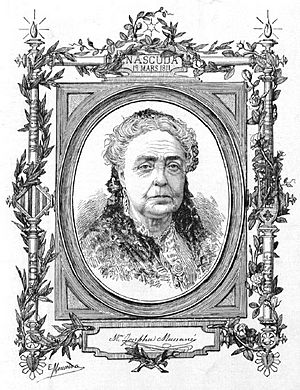María Josefa Massanés facts for kids
Maria Josepa Massanés i Dalmau (born 1811, died 1887) was an important Spanish poet from the 1800s. She was part of a movement called Romanticism, which focused on feelings and imagination.
Maria Josepa wrote about many different things. Her poems explored love, her home country, religion, and even social issues. She also wrote about the challenges women faced at that time. She wrote in both Spanish and Catalan language.
Contents
Early Life and Challenges
Maria Josepa's father, José Massanés, was a writer, architect, and military man. She likely learned her love for learning and her country from him.
Her family lived through the Spanish War of Independence. When she was just two months old, her family moved to Barcelona because of her father's military work. He was fighting against the French army.
When Maria Josepa was five, her mother passed away. Her grandparents then raised her. They had very traditional ideas and did not think girls should study much. However, her father strongly supported her education and encouraged her writing.
To help her family, Maria Josepa learned embroidery. But she still read as much as she could. She even taught herself French, Latin, and Italian!
In 1830, her life changed dramatically. Her father had to escape to France because he was in danger. Maria Josepa helped him flee. In 1833, he was able to return home. After this, her life became much calmer. This was when she started writing her first poems. Within five years, she became a well-known writer in her area.
Her First Published Works
Maria Josepa started publishing her poems in newspapers. In 1834, a poem appeared in El Vapor newspaper. At first, her poems were published without her full name.
About ten months later, she started using her initials (J.M.). She published a poem called Himno Guerrero in 1835. This poem talked about politics and land, which were usually considered topics for men at that time.
Later, in 1836, the poem María was published. It finally revealed that Maria Josepa Massanés was the true author of her earlier works. After this, she began signing her full name to her poems.
Other newspapers like El Guardia Nacional and La Religión also published her poems between 1837 and 1840. These poems were very popular. Some of her works were even translated into English. The United States government recommended them for primary schools!
Because her early poems were so well-received, Maria Josefa Massanés became an official member of the Philodramatic Society of Barcelona in 1837. She also became an honorary member of the Academy of Good Letters of Barcelona in 1838.
Time in Madrid
In 1843, Maria Josepa married Fernando González de Ortega, an army captain. They moved to Madrid for his work, living there between 1843 and 1844. This time helped her become known in important literary groups in the capital city. In 1843, she became a member of the Liceo Artístico-Literario de Madrid.
She wrote many poems during her time in Madrid. Some of these include La voz de Dios and Oh padre mío!. These were published in popular magazines and newspapers.
In 1844, the couple returned to Barcelona. Maria Josepa became an important part of Barcelona's cultural life. Her fame grew even more with the publication of a poem for the Duke and Duchess of Montpensier in 1846.
Important Books and Poems
Maria Josepa Massanés wrote several important collections of poems:
- Poesías (1841): This book included a special introduction by Maria Josepa. In it, she talked about the importance of education for women. She believed that all women should have access to public education. This book was so popular that it was printed again 20 years after her death.
- Flores Marchitas. Nueva Colección de poesías (1850): This collection featured poems about history and religion. Critics praised her writing style and how well she handled different topics.
- Descenso de la Stma. Virgen a Barcelona para la fundación de la Orden de la Merced y Misericordia (1862): This was a special play with music. It told a religious story set in Barcelona in 1218. Maria Josepa wrote other religious works, but this is the only one that still exists today.
- Garlanda poética ilerdanesa (1881): She wrote this book with other poets, J. Martí y Folguero and A. Guimerá.
- Importancia de la perfecció dels brodats (1881): This work was about the importance of perfect embroidery.
Works in Catalan
In 1858, many writers started working to bring back the Catalan language in literature. This led to the return of the Floral Games (Juegos Florales) in 1858. These were poetry contests that celebrated Catalan culture.
Maria Josepa Massanés joined this movement. She began writing and publishing poems in Catalan, her native language. Her first Catalan poems appeared in a collection called Los Trobadòrs nous (1858).
She continued to write in both Spanish and Catalan until her death. One notable Catalan work is La roja barretina catalana (1880). After she passed away, a book called Poesíes (1908) was published, collecting many of her Catalan poems.
In 1864, she won a special prize at the Jochs Florals for her poem Creurer és viurer. Her poems La roja barretina catalana and Castas espinas were highly praised and even translated into German.
Later Life
In 1869, Maria Josepa opened a school for young ladies. She did this to help her family, as political events had made their financial situation difficult. However, after her husband passed away in 1872, she had to close the school.
Around 1877, Maria Josepa started writing again. Her later poems are collected in a book called Frutos de otoño (Autumn Fruits), which was never fully published. In these poems, she continued to show her concern for society and her strong belief in the importance of women's education.
See also
 In Spanish: María Josefa Massanés para niños
In Spanish: María Josefa Massanés para niños


